Last week, Lost in Translation took a look at King Kong vs Godzilla, a match up between the giant ape that create the giant monster movie and the walking, breathing warning about atomic power that was inspired by him. Kong, though, has had several remakes, throughout the decades, the most recent being Kong: Skull Island.
One theme missing from King Kong vs Godzilla was the price of obsession. Carl Denham’s push to discover and bring back Kong led to a giant ape rampaging through Manhattan. However, Dunham never really paid the price for his obsession. Kong did. In 1933, horror movies and monster movies didn’t have the distinct types of victims that exist today, but today’s distinctions are a result of the Hays Code and subsequent movie ratings systems.
Today, there are three types of victims in a horror or monster movie, determined by type of victim. The first is the redshirt, whose only role is to allow the monster to demonstrate what it can do. Redshirts are lucky if they even get a name in most films. The second type is the deserving victim, someone who goes out of his or her way to cause others pain and receives a karmic reward via the monster. This victim tends to give sympathy to the monster. The third victim is the sympathetic victim, whose death is meant to get the audience cheering the heroes against the monster. This type of victim tends to have on screen development and is generally a likeable character. While not from a monster movie, Dead Meat from Hot Shots is a prime example, if exaggerated.
Kong: Skull Island was released in 2017 and starred John Goodman as Monarch executive Bill Randa, Samuel L. Jackson as Col. Preston Packard, Tom Hiddleston as ex-SAS member James Conrad, Brie Larson as photographer Mason Weaver, Corey Hawkins as Monarch geologist Houston Brooks, and John C. Reilly as US Army Air Force Lt Hank Marlow. The film moves the time and place of the film, from then-current 1933 in King Kong to just days after the withdrawal of American troops from Viet Nam in 1973. The beginning of the film, though, is in 1944 as the pilots of an American P-51 – Hank Marlow – and a Japanese Zero shoot each other down over an uncharted island. Both survive parachuting down and try to continue their fight on the ground, only to have the fight broken up by the arrival of Kong.
In 1973, Randa and Brooks need to push a senator for funding for an expedition to an island discovered only thanks to satellite photography. Randa needs to get the funding locked in before the war in Viet Nam is over, but the announcement occurs before he can get into the senator’s office. With some brow beating, Randa gets his funding plus a military escort. Col Packard’s helicopter squadron, now available thanks to the ceasefire and withdrawal, is assigned to join the expedition. Randa and Brooks find a tracker, ex-SAS Conrad, who charges far more than expected. Rounding out the crew, photographer Weaver is the last to board the ship.
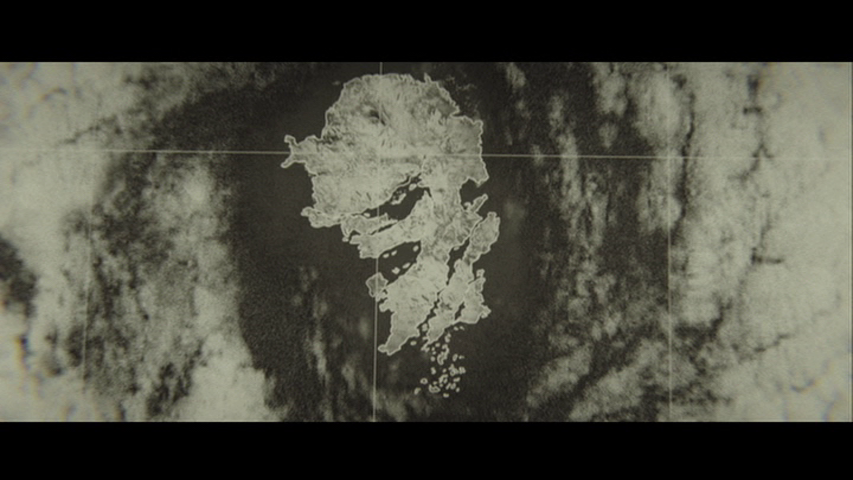
The captain of the transport ship refuses to go through the electrical storms surrounding Skull Island, so Packard and his squadron fly through it. It’s a rough flight, but once through, the skies are clear and calm. Birds take off at the sound of the choppers. Everything is calm and peaceful except for the helicopters. The team lands to start their respective jobs. The helicopters are carrying seismic charges to determine what lays below the surface and split into two separate flights with a rendezvous point at the north end of the island. The charges are dropped, giving Brooks a good idea of what lies below. As Randa expected, the bedrock has a hollow layer.
The explosions do attract attention. Not all the wildlife on the island is frightened by the the explosions. Instead, one particular part of the wildlife is drawn out to see what is happening and he is not pleased. In most monster movies, military force seldom works unless there is overwhelming firepower. Packard and his squadron do not have overwhelming firepower, though they do hurt Kong. Kong does far more than hurt the squadron. All the helicopters are destroyed and several of Packard’s men are killed. The rest are scattered across the island.
There are two tales of obsession in the movie. The first is Col. Packard’s push to destroy Kong for killing his men. Packard is willing to lose everything he has in his desire for payback. The other tale is Randa’s. Kept a secret until Packard forces Randa to tell it at gunpoint, the Monarch exec was crew on board a US Navy ship in the Pacific during WWII. The ship was destroyed with the official records saying it was enemy action. The photo of the ship Randa carries show otherwise, with rents through the hull like it had been attacked by something with giant claws.
Packard and Randa are with one set of survivors. The second set, including Conrad and Weaver, are sticking to the plan and are trrying to make it to the north end of the island. They find waht looks like an abandoned ruin, which turns out to be not so abandoned. There is a tribe living on the island, who are used to the megafauna that lives there. Kong isn’t the only giant animal; there are also giant water buffalo who are content to leave things in peace. The tribe produces a second surprise, Hank Marlow.
Marlow and the Janapese pilot survived their encounter with Kong, mostly by not shooting him first. Neither had a loaded, working pistol, so they managed to escape and work togther once they found the tribe. The Japanese pilot died six years after crashing on Skull Island, killed by what Marlow calls “skullcrawlers”, giant two limbed lizards. The skullcrawlers live below the ground, in the hollow of the bedrock. The only thing keeping them from bubbling up and spreading like vermin is Kong, the last of his kind.
A third survivor, Jack Chapman, got caught alone. During the war, he was known in the sqaudron for all the letters he wrote to his son, Billy, to the point where his squadmates made fun of him for it. Alone, all he has is his letters to his son to keep him going. Alone, though, there’s nothing he can do when a skullcrawler finds him.
Kong: Skull Island doesn’t bring King Kong to New York. Kong is needed on Skull Island to keep the skullcrawlers in check. The hunt for Kong takes the entire movie, ending in a climactic battle between Kong and the largest of the skullcrawlers. Packard and Randa’s obsessions lead to their deaths, as fitting for deserving victims.
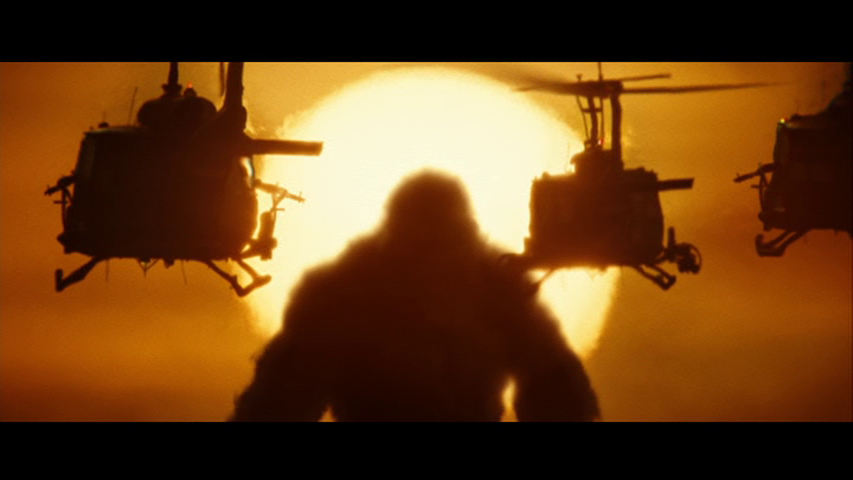
The movie takes its inspiration from films set during the Viet Nam war, including Platoon and Apocalypse Now. Kong is the largest he has been on screen. Instead of stop-motion animation, motion-capture CGI was used, giving the giant ape a more natural movement. The idea of beauty felling the beast didn’t quite make it into the film; while Kong met Weaver, it wasn’t like Kong meeting Fay Wray’s Ann Darrow. Yet that meeting did let Kong know that not every newcomer was out to kill him.
Kong: Skull Island was more focused on the perils of obsession, as seen with Packard and Randa. There’s also some world building going on. Randa and Brooks were researching the Hollow Earth Theory where there is another civilization lurking underneath the surface of the world. Skull Island proves to be a way in, except for the small problem of the megafauna living on and under the island. A post-credits sequence shows that Kong is not the only giant monster around.
The remake takes a different approach, one that reflects not just the time it is set in but the time it was made in. In 1933, explorers sought out new locations and brought back proof, from unusual flora and minerals to living creatures not found anywhere else. Today, concerns about potential ecological devestation caused by removing or introducing a species from an environment can point to specific examples, such as cane toads in Australia. Removing Kong from Skull Island to take him to New York City would cause environmental havoc in both locations, something known in 1973. Keeping the focus on the hunt for Kong, though, covers most of the original movie. While the escape up the Empire State Building is an iconic scene, it’s just the climax of the original Kong.
Kong: Skull Island does take its cues from the original. There is a scene where Kong is caught in old anchor chains during the climactic battle, taken from the 1993 film where Kong is chained on stage. In both the original and the remake, Kong escapes the chains. The sea voyage is cut back in the remake, treated as a montage, so that the film can get to the action on Skull Island sooner. In 2017, King Kong is a known element, so delays in seeing him are going to leave audiences unsatisfied.
The remake builds a new mythology for the original giant monster. Kong isn’t just a giant ape worshipped as a god by a primitive tribe. He is a defender of the island and everything that lives on it, giving the film depth. The original Kong was about the spectacle. Skull Island is about the human condition and ecological dangers, a reflection not of 1933 but of 1973 and of 2017.
Giant monsters are a draw. A staple of B-movies in the Fifties and Sixties, giant monsters allow for the visceral feel of seeing civilization destroyed. They’re more a force of nature than a living being, an unnatural disaster that takes more than just human ingenuity to stop, let alone destroy. But the giant monster had to start somewhere, and that somewhere is 1933’s King Kong.
Kong features the giant ape, hinted at in legend. Starring Fay Wray as aspiring actress Ann Darrow, Robert Armstrong as infamous director Carl Denham, Bruce Cabot as love interest Jack Driscoll, and Frank Reicher as Captain Englehorn, Kong tells the story of one man’s obsession to be the most successful and famous director and one ape’s tragic encounter with beauty. Denham has learned of a mythical being on an uncharted island discovered by a Norwegian freighter and is determined to go and film this creature. When agencies refuse to allow their actresses to talk to him, Denham heads out to do his own talent scouting. He discovers Ann Darrow, a starving actress on a streak of bad luck. He gives her a proposition, which has to reword – she can star in his next blockbuster if she can leave the next morning.
Ann’s appearance onboard the Venture causes some stir. The first mate, Driscoll, doesn’t take immediately for having a woman on board, a superstitious holdover. Denham and his money speak louder for the Captain of the Venture, though. The ship sets off with Ann aboard. Denham has a specific course to be followed, going away from even small chartered islands to the middle of the sea, where a lone island sits. According to what Denham discovered from the Norwegian freighter, the island has a small village on a peninsula, blocked off from the rest of the island by a large wall. Beyond the wall is a god that the villagers worship. Denham believes that whatever this god is will be worth capturing on film for audiences across the world to see.
During the trip, Ann and Jack grow closer to each other. Jack is kept busy on his shifts, but Ann has nothing else to do once Denham is done with his test shots of her. Jack’s beliefs about women on a ship being bad luck lessens.
On the island, Denham takes a small contingent with him to watch the island natives. They arrive in time to see a ritual, where a young woman is being set up to be sacrificed to the island’s god. However, the chieftain (Noble Johnson) sees Denham trying to film. Denham, through Englehorn, tries to parlay with the tribe. The chieftain wants to trade for Ann and is denied. Denham and the crew are forced to leave and go back to the Venture.
The chieftain is not one to be rebuffed. He takes a small group with him to the Venture and kidnaps Ann. When her disappearance is discovered, Denham and Jack take several armed men back to the island, arriving in time to see the island god appear. Kong is smitten by Ann and takes her before Jack can do anything to free her. Jack and Denham give chase, but beyond the wall is an island filled with prehistoric wonders and dangers. Even Kong must fight through these dangerous creatures.
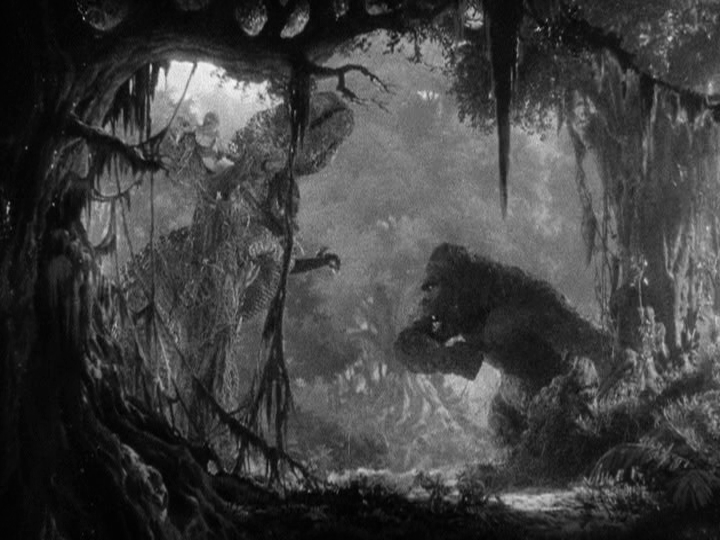
Jack manages to rescue Ann, though only he and Denham survived being beyond the wall. Jack and Ann return to the village with Kong on their heels. The massive doors in the wall aren’t enough to keep the enrage giant ape out. King breaks through and wreaks havoc on the village. With effort, Denham uses large gas grenades to knock out Kong so that he can be secured for the trip back to New York City. Denham isn’t just seeing film revenues; he’s looking at being big on Broadway with the new star attraction, King Kong.
Opening night becomes closing night. Photos by papparazzi anger Kong and the steel restraints he’s in aren’t enough. He grabs Ann again and climbs up various buildings until he finds the tallest around, the Empire State Building. Too far for anyone on the ground to deal with, the US Army Air Corps is called in to send a flight of biplanes to deal with Kong.
Kong is a masterwork of stop-motion animation by Willis O’Brien, who would later mentor Ray Harryhausen. Edits between the stop-motion Ann and the real Fay Wray are seamless. Kong has a presence on screen, as real as the actors around him. King Kong would become the top grossing film of 1933 and Fay Wray became known for her role as Ann Darrow.
Hollywood dominated giant monster movies until the early Sixties, then Japan, on the strength of Godzilla took over. The original Godzilla was a morality play about the dangers of atomic energy and weaponry, with Godzilla destroying Tokyo on a rampage and only stopped through drastic means. Later entries in the films had Godzilla seen as a threat and menance or as the defender of Earth, though not necessarily humanity. Naturally, when there’s two heavyweight kings, people want to see what happens when the clash, thus the 1962 King Kong vs Godzilla.
The film begins with a newscast with a story about an earthquake in the Arctic, breaking apart icebergs. The changes in the currents result in a nuclear submarine being sent to investigate. Meanwhile, the head of Pacific Pharmaceuticals, Mr. Tako (Ichiro Arishima), is upset that Tokyo TV’s ratings are abysmal. He learns of the newly discovered Faro Island and its monster and sends Sakurai (Tadao Takashima) and Fujita (Kenji Sahara) to bring the monster back, whatever it is.
The submarine finds an unusual iceberg, one emitting radiation. It crashes in the the berg, causing it to crack open, revealing Godzilla, frozen since the 1955 movie. Now free, Godzilla destroys the sub with his atomic breath and begins his march towards Japan. On the island, Sakurai and Fujita arrive in time to see a ritual by the native islanders get interrupted by a giant octopus crawling out of the ocean. The village appears to be doomed but the island god, King Kong, arrives to battle the creature. The octopus is sent back to the ocean. After the battle, the villagers set out clay pots filled with the juice of a local red berry, a non-addictive narcotic. Kong drinks from the pots and falls asleep.
Sakurai and Fujita get Kong tied to a raft to be dragged back to Japan by ship. Mr. Tako arrives to check up on his people, and has to be told not to rest on the plunger detonator for the explosives set up on the raft in case Kong wakes up and tries to escape. The ship, though, is stopped by a Japanese Self-Defense Force ship and is ordered to take Kong back to Faro Island. One daikaiju is more than enough, thank you very much.
Godzilla reaches the shores of Hokkaido and lays waste to the country side. The JSDF sends out everything it has – tanks and artillery – but is repulsed with casualties. To try to stop Godzilla, the JSDF sets up a large pit, Kong, though, wakes up and despite the explosives, escapes to reach mainland Japan. He finds Godzilla.
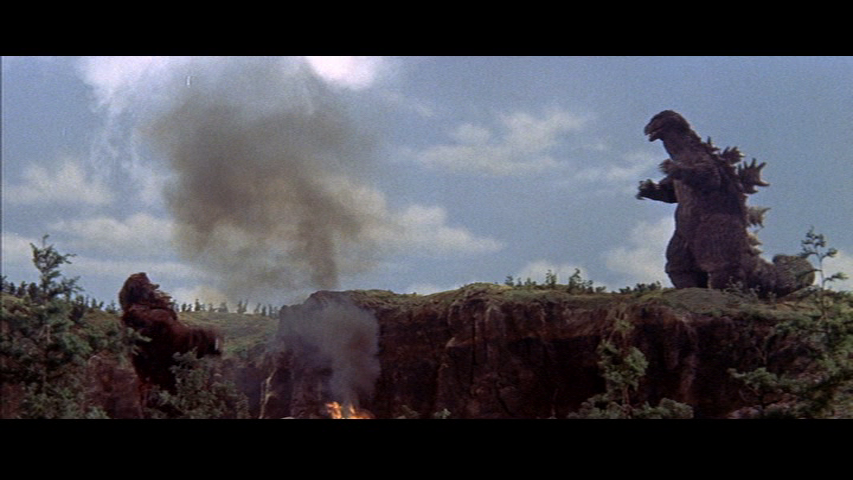
The first meeting in the film is a draw. Kong hurls boulders at Godzilla but is repulsed by his opponent’s atomic breath. Godzilla then goes on to fall into the JSDF’s trap but escapes it unarmed. Tokyo, being in the path of Godzilla’s destruction, is evacuated. Power lines with a million volts are set up in the way to stop Godzilla, but the electricity instead powers Kong. The JSDF manage to stop Kong using a gas made from the same red berries found on Faro Island.
Realizing that the only way to stop a giant monster is with another giant monster, the JSDF flies the sleeping Kong to Mount Fuji, where Godzilla was last seen. In the final battle between the two, Godzilla gets an early edge with his atomic breath. It’s not until Kong is struck by lightning that he has the strength to fight back. The battle results in both falling through a village and landing in the Pacific Ocean. Kong is last seen swimming away, while there is no trace of Godzilla. At best, the battle is a draw, but Japan is safe, for now.
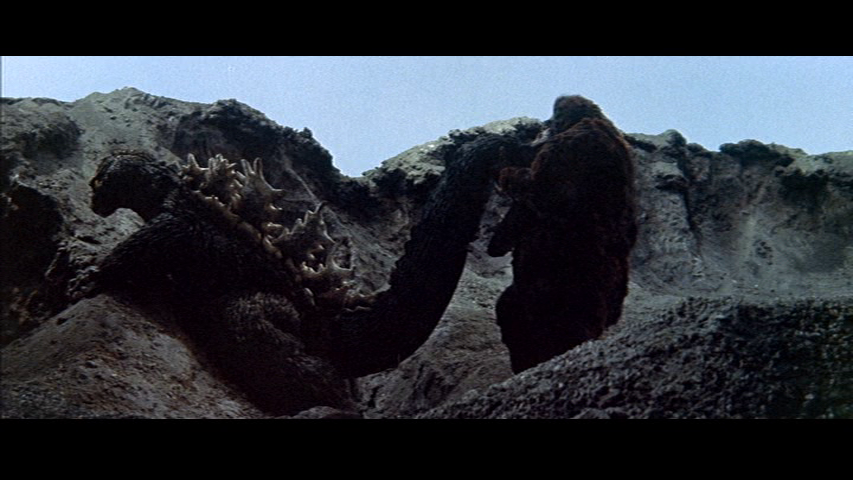
/King Kong vs Godzilla/ exists solely to have the two giants battle each other. Each has their own strengths and weaknesses, though some were created just for this movie. Kong’s background is very close to the 1933 movie, with a small island with giant creatures and a small village of humans treating Kong as a god. Godzilla is a threat to Japan, leaving a trail of destruction and is unstoppable by conventional means. The first fight is a technical win for Godzilla; Kong escaped when he realized that he wasn’t able to get past Godzilla’s atomic breath. The film even tosses in a “beauty and the beast” motif for Kong, with the giant ape falling for Sakurai’s sister, Fumiko (Mie Hama). Even with the changes for setting, the film keeps close to the mythology set by King Kong; the giant ape is recognizable.
The biggest change for Kong is that he’s now played by Shoich Hirose instead of being stop-motion animation. Godzilla has always been portrayed by a man in the suit, this time by the original Godzilla actor, Haruo Nakajima. The change means that Kong’s motions are more fluid than stop-motion animation allows. Kong, though, is still recognizable as Kong.
For a movie that is about a battle between the most famous giant monsters, King Kong vs Godzilla takes effort to present Kong’s background faithfully. The change in the nature of the character’s portrayal allows for Kong to throw rocks, leading to a brains versus brawn battle. The end result removes the slow discovery of Kong, but the movie’s purpose wasn’t to re-introduce the character but to get him to Japan for the big fight. In the end, Kong remains king, with the film staying close to his origins, only giving him a boost to deal with Godzilla at the end.




